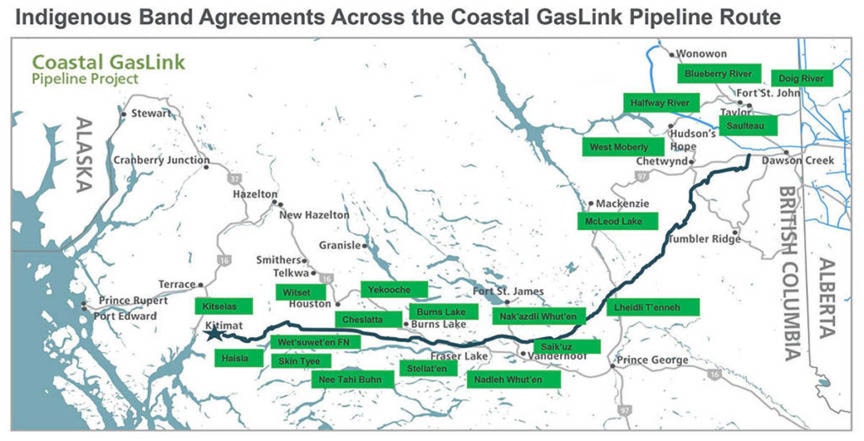Despite the headline-grabbing news coming from the Gitdumt’en anti-pipeline site, most First Nations living near the LNG pipeline route support the project.
READ MORE: RCMP arrest 14 people in northern B.C. over anti-LNG pipeline protest
At least 20 First Nations from Fort St. John to Kitimat have signed agreements with LNG Canada, Donald MacLachlan, media officer with the First Nations LNG Alliance told Lakes District News.
The Indigenous groups around Burns Lake who have signed onto the the project include the Stellat’en, Nadleh Whut’en, Yekooche, Witset, Nee Tahi Buhn, Skin Tyee, Burns Lake, Wet’suwet’en, and Cheslatta Carrier First Nations.
Chief Rene Skin of the Skin Tyee said his First Nation was among the first to lend its support to LNG.
“We’ve always been in support of the pipeline. We voted together,” he said.
The chief regards the project as offering several benefits to his First Nation.
“Lots to do with jobs, up and coming housing, people will be able to start their own companies. For years to come there will be a lot of benefits.”
Skin couldn’t offer many specifics on the benefits, which are detailed in the confidential term sheet that was negotiated with LNG.
In general, the agreements signed with the First Nations near the pipeline are worth millions of dollars, MacLachlan explained.
“$620 million in conditional contracting and employment opportunities, and another $400 million in contracting opportunities for local and Indigenous businesses,” he said.
Though much attention has focussed on the opposition of hereditary chiefs towards the pipeline, Skin Tyee band councilor Helen Michelle said a long process of negotiation between Skin Tyee members and hereditary chiefs eventually led to an agreement with Coastal GasLink (CGL).
“It was difficult for us, but we supported CGL,” she said. “We discussed it thoroughly and we struggled with it. We agreed upon it for our future generations. No other chiefs speak for us or our territory. We speak for ourselves. We speak for our territory.’”
Burns Lake First Nation Chief Dan George - who is also the First Nations LNG Alliance chair - has said there are hereditary chiefs who support the project.
“Helen Michelle and Skin Tyee are not alone. Other First Nations such as the Haisla and Kitselas have declared their support for LNG.”
Karen Ogen-Toews, CEO of the First Nations LNG Alliance, explained that amidst the media coverage of the Gitdumt’en situation, regular people from the Wet’suwet’en community are caught in the middle.
“The backlash Wet’suwet’en people are facing, whether they are for or against the project, is devastating. Our leaders, elected or hereditary, are advancing what they believe is right, and as such all deserve respectful treatment. Social-media campaigns led by non-Indigenous groups are simply not contributing to a solution.”
The activity at the Gitdumt’en blockade camp near the Morice River Bridge south of Houston has been trending on Twitter under the hashtag #unistotencamp.
“There is no doubt that the hereditary leadership has some responsibility for land and natural resources within our territory,” Ogen-Toews added. “At the same time, the elected leadership has responsibility for our people and the external affairs of their First Nation.”
